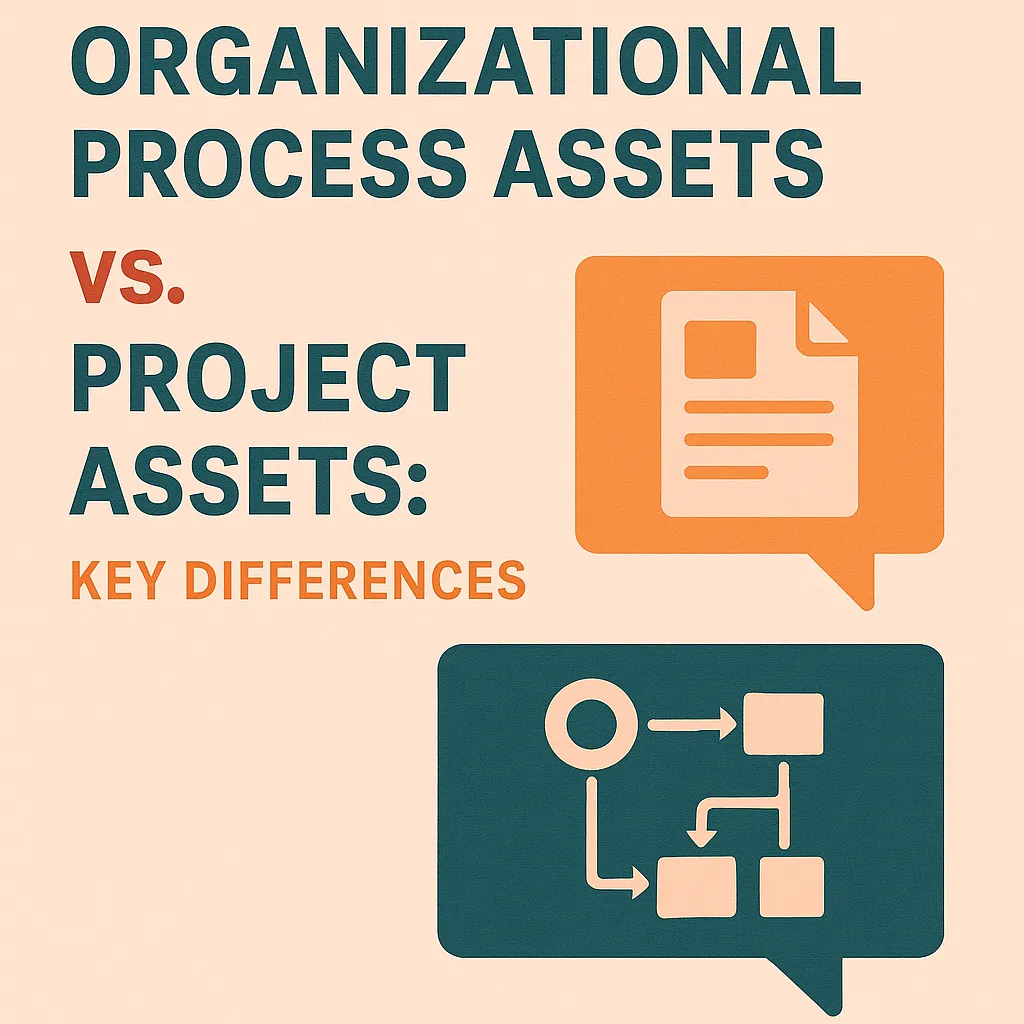Introduction
The effective utilization of various assets is paramount to achieving project success. Assets serve as the backbone of project execution, providing the necessary resources, knowledge, and frameworks that guide project teams through their endeavors. Among these assets, two key categories stand out: Organizational Process Assets (OPA) and Project Assets. Understanding the distinctions and interactions between these asset types is crucial for new project managers and students who are just beginning their journey in this field.
Organizational Process Assets (OPA) refer to the accumulated knowledge, processes, and resources that an organization has developed over time. These assets include templates, guidelines, lessons learned from previous projects, and historical data that can inform current and future project decisions. OPAs are essential as they provide a repository of best practices and insights that can enhance project efficiency and effectiveness [1][10].
On the other hand, Project Assets are specific to individual projects and encompass the resources, tools, and documentation created or utilized during the project lifecycle. This includes project plans, schedules, budgets, and deliverables that are unique to a particular project. While Project Assets are critical for managing the day-to-day operations of a project, they do not carry the same organizational-wide knowledge and experience that OPAs provide [6][15].
Distinguishing between Organizational Process Assets and Project Assets is vital for new project managers for several reasons:
- Enhanced Decision-Making: By leveraging OPAs, project managers can make informed decisions based on historical data and lessons learned, reducing the likelihood of repeating past mistakes [11][13].
- Improved Efficiency: Understanding how to utilize both asset types effectively can streamline project processes, leading to better resource management and time savings [2][12].
- Strategic Alignment: Recognizing the role of OPAs in aligning projects with organizational goals ensures that project managers contribute to the broader objectives of the organization [4][14].
What are Organizational Process Assets (OPAs)?
Organizational Process Assets (OPAs) are critical components in project management, serving as a repository of knowledge and resources that organizations accumulate over time. These assets play a vital role in enhancing project efficiency, consistency, and overall success. Understanding OPAs is essential for new project managers and students as they navigate the complexities of project execution.
Definition of Organizational Process Assets
OPAs encompass the internal assets, tools, and knowledge repositories that an organization utilizes to support its project management efforts. They include a variety of resources that are specific to the organization and are designed to streamline processes and improve project outcomes. Essentially, OPAs represent the collective knowledge, experience, and information that an organization has gathered from past projects, which can be leveraged for future initiatives [2][8].
Examples of Organizational Process Assets
Organizational Process Assets can take many forms, including but not limited to:
- Templates: Standardized documents that provide a framework for project planning, execution, and reporting.
- Policies: Established guidelines that dictate how projects should be managed within the organization.
- Procedures: Step-by-step instructions that outline the processes to be followed during project execution.
- Historical Data: Records of past project performance, including lessons learned, which can inform future decision-making and risk management strategies [6][15].
These examples illustrate the diverse nature of OPAs and their importance in providing a structured approach to project management.
How OPAs Support Project Management Processes and Decision-Making
OPAs significantly enhance project management processes by offering a wealth of information and resources that project managers can draw upon. They serve several key functions:
- Facilitating Consistency: By utilizing established templates and procedures, project managers can ensure that projects are executed in a consistent manner, reducing variability and increasing reliability [13].
- Improving Efficiency: Access to historical data and lessons learned allows project teams to avoid repeating past mistakes and to implement best practices, thereby streamlining project execution [11][14].
- Supporting Decision-Making: OPAs provide valuable insights that can guide project managers in making informed decisions. For instance, historical performance data can help in assessing risks and forecasting project outcomes [12][14].
What are Project Assets?
Understanding the various types of assets is crucial for new project managers and students. Among these, Project Assets play a significant role in the successful execution and completion of projects.
Definition of Project Assets
Project Assets refer to the tangible and intangible resources that are specifically created or utilized during the lifecycle of a project. These assets are essential for guiding project activities and ensuring that objectives are met efficiently. Unlike Organizational Process Assets (OPAs), which are broader and encompass a range of organizational knowledge and resources, Project Assets are directly tied to the specific project at hand.
Examples of Project Assets
Project Assets can take various forms, including but not limited to:
- Project Plans: Comprehensive documents that outline the scope, objectives, timelines, and resources required for the project.
- Project Documents: This includes all documentation generated throughout the project, such as meeting minutes, status reports, and risk assessments.
- Deliverables: The tangible outcomes produced as a result of project activities, such as products, services, or results that fulfill project requirements.
- Work Breakdown Structure (WBS): A hierarchical decomposition of the total scope of work to accomplish project objectives and create deliverables.
- Change Requests: Formal proposals for altering any aspect of the project, which are essential for managing scope and ensuring stakeholder alignment.
Role of Project Assets in Achieving Project Objectives
Project Assets are instrumental in achieving project objectives for several reasons:
- Guidance and Structure: They provide a structured approach to project management, ensuring that all team members are aligned with the project goals and methodologies.
- Facilitation of Communication: Well-documented project assets enhance communication among stakeholders, making it easier to share information and updates.
- Performance Measurement: Project Assets allow for tracking progress against the project plan, enabling project managers to identify deviations and implement corrective actions promptly.
- Knowledge Transfer: They serve as a repository of knowledge that can be referenced in future projects, contributing to continuous improvement and learning within the organization.
Key Differences between OPAs and Project Assets
Understanding the distinctions between Organizational Process Assets (OPAs) and Project Assets is essential for new project managers and students entering the field of project management. Both types of assets play significant roles in the successful execution of projects, but they serve different purposes and have unique characteristics. Here are the key differences:
Ownership:
- Organizational Process Assets (OPAs) are owned by the organization as a whole. They encompass the collective knowledge, processes, and tools that the organization has developed over time. This includes templates, guidelines, and historical data that can be leveraged across various projects to enhance efficiency and effectiveness [6][10].
- In contrast, Project Assets are specific to individual projects. These assets are created and utilized solely for the duration of a project and may include project plans, schedules, and deliverables that are unique to that particular initiative [12].
Lifecycle:
- OPAs have a longer lifecycle; they are enduring resources that can be reused across multiple projects. This longevity allows organizations to build upon their past experiences and continuously improve their project management practices [11][14].
- On the other hand, Project Assets are typically temporary. They are developed for the specific needs of a project and are often discarded or archived once the project is completed. This temporary nature means that while they are crucial for project success, they do not contribute to the organization’s long-term knowledge base [12][14].
Scope and Purpose:
- The scope of OPAs is broader, as they are designed to support the overarching goals of the organization. They provide a framework that guides project managers and teams in aligning their work with the strategic objectives of the organization [10][15].
- Conversely, Project Assets are focused on achieving project-specific outcomes. Their purpose is to facilitate the successful delivery of a project by providing the necessary tools and resources tailored to that project’s unique requirements [12][14].
The Interaction between OPAs and Project Assets
Understanding the relationship between Organizational Process Assets (OPAs) and Project Assets is crucial for new project managers and students. These two types of assets play distinct yet complementary roles in ensuring project success. Here’s how they interact and support each other throughout the project lifecycle.
Utilizing OPAs to Develop Project Assets
Organizational Process Assets are the foundational tools and resources that project managers leverage to create Project Assets. OPAs encompass a wide range of materials, including templates, policies, procedures, and historical data from previous projects. By utilizing these resources, project managers can:
- Streamline Project Planning: OPAs provide standardized templates and guidelines that help project managers efficiently plan and execute projects. This reduces the time spent on creating documentation from scratch and ensures consistency across projects [1][11].
- Enhance Decision-Making: Access to historical records and lessons learned from past projects allows project managers to make informed decisions, thereby increasing the likelihood of project success [3][12].
- Establish Best Practices: By integrating OPAs into their workflows, project managers can adopt best practices that have been proven effective in previous projects, leading to improved performance and outcomes [2][15].
The Cycle of Feedback from Project Assets to OPAs
The relationship between OPAs and Project Assets is not one-sided; it is a dynamic cycle of feedback that fosters continuous improvement. As project managers develop Project Assets—such as project plans, schedules, and performance reports—they gather valuable insights and data that can be fed back into the OPAs. This feedback loop serves several purposes:
- Refining OPAs: Insights gained from the execution of Project Assets can highlight areas where OPAs may need updates or enhancements. For instance, if a particular template proves ineffective, it can be revised based on the feedback from the project team [4][14].
- Capturing Lessons Learned: Each project provides an opportunity to document lessons learned, which can then be integrated into the OPAs. This ensures that future projects benefit from the experiences of past projects, creating a repository of knowledge that enhances organizational learning [3][15].
- Promoting Adaptability: The continuous feedback mechanism allows organizations to adapt their OPAs to changing project environments and requirements, ensuring that they remain relevant and effective [8][12].
Importance of Integrating OPAs and Project Assets for Project Success
The integration of OPAs and Project Assets is vital for achieving project success. When project managers effectively utilize OPAs to inform the development of Project Assets, they create a cohesive framework that supports project execution. Key benefits of this integration include:
- Increased Efficiency: By leveraging OPAs, project managers can reduce redundancy and streamline processes, leading to more efficient project execution [1][11].
- Enhanced Quality: The use of established OPAs ensures that Project Assets are developed with a focus on quality and adherence to organizational standards, which can significantly improve project outcomes [2][15].
- Sustained Improvement: The feedback loop between Project Assets and OPAs fosters a culture of continuous improvement, where lessons learned are systematically integrated into organizational practices, leading to better performance over time [4][14].
Best Practices for Managing OPAs and Project Assets
Understanding the distinctions between Organizational Process Assets (OPAs) and Project Assets is crucial for new project managers and students. Both asset types play significant roles in ensuring project success, but they serve different purposes and require unique management strategies. Here are some actionable strategies for effectively managing both OPAs and Project Assets.
1. Documentation and Updating of OPAs
- Establish a Central Repository: Create a centralized hub for all OPAs, such as templates, historical data, and procedures. This ensures that all project team members have easy access to the necessary resources, promoting consistency and efficiency in project execution. Project management software, like ProjectManager, can facilitate this by providing unlimited file storage and industry templates to streamline the process [1].
- Regular Reviews and Updates: Schedule periodic reviews of OPAs to ensure they remain relevant and useful. As projects evolve, so do the processes and lessons learned. By documenting updates and changes, organizations can build a robust knowledge base that benefits future projects [10][15].
2. Organizing and Maintaining Project Assets
- Categorization and Tagging: Implement a systematic approach to categorize and tag Project Assets, such as contracts, registers, and assessment tools. This organization helps project teams quickly locate the necessary documents and resources throughout the project lifecycle [13].
- Version Control: Utilize version control systems to track changes in Project Assets. This practice not only preserves the integrity of documents but also allows teams to revert to previous versions if needed, ensuring that the most accurate and up-to-date information is always available [9].
- Lifecycle Management: Develop a clear process for managing Project Assets from initiation to closure. This includes defining roles and responsibilities for asset management, ensuring that all team members understand their contributions to maintaining these assets [11].
3. Importance of Training and Knowledge Sharing
- Training Programs: Implement training sessions focused on the importance of OPAs and Project Assets. New project managers should be equipped with the knowledge and skills to effectively utilize these resources, enhancing their project management capabilities [12].
- Knowledge Sharing Platforms: Foster a culture of knowledge sharing within the organization. Encourage team members to share insights and experiences related to OPAs and Project Assets. This can be achieved through workshops, collaborative tools, or internal forums, which can significantly enhance the collective knowledge of the team [2][4].
- Mentorship Opportunities: Pair new project managers with experienced mentors who can guide them in understanding the nuances of managing OPAs and Project Assets. This one-on-one interaction can provide invaluable insights and practical tips that are not easily found in textbooks [3].
By implementing these best practices, new project managers can effectively manage both Organizational Process Assets and Project Assets, leading to improved project outcomes and a more efficient project management process. Understanding the interplay between these asset types will not only enhance individual project performance but also contribute to the overall success of the organization.
Conclusion
Understanding the distinctions between Organizational Process Assets (OPAs) and Project Assets is crucial for new project managers and students.
- Definitions Recap: OPAs are the accumulated knowledge, processes, and procedures that an organization has developed over time, serving as a valuable resource for enhancing project execution and management. They can be categorized into explicit assets, such as documented processes and templates, and tacit assets, which include the skills and experiences of team members [3][12]. In contrast, Project Assets refer specifically to the resources and materials that are created or utilized during a particular project, including project plans, schedules, and deliverables.
- Key Differences: The primary distinction lies in their scope and application. OPAs provide a broader organizational context that can inform and guide multiple projects, while Project Assets are unique to individual projects and are often transient in nature. Understanding this difference allows project managers to effectively leverage both types of assets to optimize project performance and ensure successful outcomes [10][15].
- Leveraging Both Asset Types: New project managers are encouraged to utilize both OPAs and Project Assets to enhance their project management practices. By tapping into the wealth of knowledge and best practices encapsulated in OPAs, alongside the specific resources developed for their projects, managers can significantly increase their chances of success. This dual approach not only fosters consistency and efficiency but also aids in navigating the complexities of project execution [1][6].
As you embark on your journey in project management, consider exploring further learning resources to deepen your understanding of these concepts. Engaging with literature, attending workshops, or participating in online courses can provide valuable insights and tools to help you effectively manage projects and leverage both OPAs and Project Assets for optimal results.
Find out more about Shaun Stoltz https://www.shaunstoltz.com/about/.
This post was written by an AI and reviewed/edited by a human.



